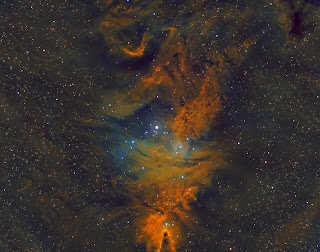I have been wanting to capture these together since purchasing the 200mm lens a couple of years ago. The Orion Nebula (M42) and the Horsehead (Barnard 33) - Flame Nebula (SH2-277) complex are some of the most imaged space objects captured by amateur and professional astronomers alike. Their beauty is unmatched and the complex nature of swirling winds of gas are fascinating. They are all part of the Orion Molecular cloud which is an immense cloud of gas and dust some 1,000 to 1,400 light-years away. The Orion Nebula is a huge stellar nursery and one of the closest to Earth. It also happens to be visible to the naked eye if you have good vision and a dark sky but is easily seen with binoculars - of course it would not show the colors but some structure would be visible. The Horsehead - Flame Complex is invisible to the naked eye but is rather easy to find as it surrounds the end star of Orion's belt (Alnitak).
Imaging took over three weeks due to weather conditions. I originally had high hopes to use my very old (over 10 yrs) computer to run my Atlas Pro mount, do plate-solving, control the camera, and run the autoguider. Well that pipe-dream ended pretty quickly so I did it the old fashioned way and just slewed tot he target. Collecting RGB is not a problem as you can use live view, however, Ha is a different story as only brightest stars are visible which makes locating and fusing difficult. Add to that I was doing this over successive nights so I had to get it in the exact orientation - the good news is the way I had my camera mounted on the home bracket keeps it in the same orientation. The computer problem was fixed by ordering a refurbished Lenovo ThinkPad for $300 to run my gear. You do not need a top of the line computer to run astrophotography equipment like you do for processing programs.
The original RGB data looked horrible so it required heavy processing which is one of the reasons I decided to collect some Ha data. I collected unguided 60-second RGB and Ha data but also collected 5-second subframes for the core of Orion. The addition of the Ha data really improved this image.
I made a video which shows my trials and tribulations along the way. Also, some of the raw stacked images and processing is shown:
Dates: 2-5-21, 2-8-21, 2-9-21, 2-21-21, 2-25-21
https://kurtzeppetello.smugmug.com/
http://astroquest1.blogspot.com/
https://www.astrobin.com/users/kurtzepp/collections/
http://youtube.com/c/AstroQuest1
Camera: Canon T3i/600D modified
Focal Length: 200mm
f/3.5
Mount: Orion Sirius
Filter: Astronomik Ha
Autoguiding: None
Exposure: Ha 212 x 60, RGB 96 x 60
Temp: -2 C
Processing: PixInsight, Photoshop, Topaz DeNoiseAI.
https://kurtzeppetello.smugmug.com/
http://astroquest1.blogspot.com/
https://www.astrobin.com/users/kurtzepp/collections/
http://youtube.com/c/AstroQuest1




